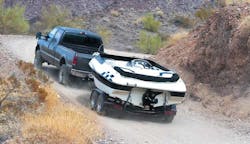Knowledge is power, especially for independent tire dealers who realize that more product knowledge about service trailer tires powers more sales.
Service trailer tires are used to tow everything from boats to livestock to family campers and landscaping equipment. Familiar to all, trailer tires are misunderstood by most. Manufacturers and distributors agree there are plenty of opportunities to improve understanding of this specialized tire.
What a trailer tire is not
“I see the same mistakes every day,” says Richard Hogg, specialty tire research and development manager for Carlisle Transportation Products, a division of Carlisle Companies Inc. “They look at a trailer tire like a passenger tire. They look at the tread as a measure of the life of the tire and disregard the irregular duty cycle of trailer tire performance requirements. As trailers sit in storage, often exposed to damaging sunlight for extended periods, the internal structure of the tire is damaged. Passenger, light truck and service trailer tires are very different and engineered for very different purposes.”
Who thinks trailer tires are just like car tires? Usually it is the customer in front of the service counter who is towing a boat, camper or horse trailer. But sometimes the person behind the counter does, too.
A trailer tire is designed to carry heavy loads as it rolls behind the vehicle pulling it. Its sidewalls are stiff to reduce trailer sway. In comparison, the sidewall of a passenger or LT tire is flexible for handling, cornering and braking purposes while providing a smooth ride for the vehicle’s occupants.
“It seems some dealers are not as well versed on trailer tires as they are on other products,” says Doug Addis, sales manager for Maxxis International – U.S.A. “Our experience indicates consumers are getting a lot of their misinformation on trailer blogs and forums, which are not reliable sources. Trailer owners are concerned about their tires and are frustrated about where to go to get the right answers.”
Independent tire dealers are the natural choice, according to Eric Yang, automotive marketing manager for American Kenda Rubber Industrial Co. Ltd. But there could be a catch. “The consumer will generally trust the dealer to select the right tire for consumers. Unfortunately, dealers may also not have the most accurate information about the trailer tires and do not educate the consumers correctly.”
Don’t go by the tread
Trailer tires of any type can fail even if there’s plenty of tread. Oxidation of the rubber, not miles driven, wears out trailer tires. Carlisle recommends replacement every three to five years. “Think of an older couple who dreams of a vacation in their travel trailer. As the tire sits for 10 months, often at high temperatures and under a static load, the internal structure of the tire breaks down. Then the couple fires up the trailer for a trip and can’t understand why a tire with plenty of tread fails,” says Hogg.
When trailer tire failure interrupts a road trip, the motorist usually finds the nearest tire dealer. “It helps if a dealer can explain the duty cycles of trailer tires and why tread depth is not a measure of the life of a trailer tire. Trailer tires are backed over curbs, driven into salt water, loaded over weight limits, and stored under load without movement or maintenance. It’s a whole different world,” says Hogg.
Match the tire to the load
Beyond design and life expectancy, the load carrying capacity, air pressure and speed ratings of trailer tires are also misunderstood, according to Yang. “Some of the most common issues we face in trailer tires are similar to the issues we face in automotive radial tires. Trailer tires are even more sensitive to loading, air pressure, and speed ratings due to the extreme conditions they are subjected to.”
Maxxis sees the same issues, says Addis. “There is a lot of confusion on correct inflation pressures and load carrying capabilities. We get inquiries from consumers on these issues daily.”
[PAGEBREAK]
Although some people are asking questions, many others are not, according to TBC Corp. “Most consumers do not seem to be aware that trailer tires can be dangerously overloaded even though max air pressure is maintained in the tires. Secondly, most consumers aren’t aware trailer tires have max mph speeds stamped on sidewalls, i.e., 65 mph, which are oftentimes exceeded,” says Kenneth Dick, president, specialty tire product group for TBC.
Too much weight and too low air pressure cause most of the trailer tire failures motorists bring to Pete’s Tire Barns Inc. “We have seen people blow tires right off the rims,” says Pete Gerry, president. His Orange, Mass.-based dealership is tied for 60th on the Modern Tire Dealer 100 with 19 stores.
“Many times people tend to sell what they have in stock and that causes problems. They need to sell what is needed to do the job,” says Gerry. To recommend the correct tire, a dealer needs to know the actual weight of the load. But customers add weight in unexpected ways. Stowing camping gear, food and beverages, fuel and other equipment in a boat or camper overloads the trailer tires. Filling a mobile home with citrus or a boat with coolers of lobster for the trip home will exceed a trailer tire’s carrying capacity. Tires are overloaded when people buy a bigger boat but continue to use the old trailer.
Maintaining maximum air pressure and pointing out maximum highway speeds isn’t enough to ensure trailer tires are not operating in an overloaded condition when total load is determined by the trailer weight plus cargo in relationship to tire air pressure, according to Dick.
“Total load can be significantly impacted by the unrestricted amount and weight of personal items consumers pack inside their towable RV, boat or personal use trailer. Unfortunately in overloaded trailer applications with more than one axle, when one tire fails, the others are more likely to fail as well. The solution is making sure the dealer is recommending the proper size and load carrying capacity tire to meet consumers’ needs and use of their trailer,” he says.
Too much weight produces excessive heat, which causes the sidewall to rupture. Customers need to be told that a tire with a heavier ply is needed to carry the additional weight. “Sometimes you need to get a customer to go to the scales. You have to know the weight of the trailer and what they are carrying to recommend the right tire,” says Gerry.
Proper air pressure keeps the sidewall stiff for straight tracking behind the tow vehicle. A trailer tire loses about a pound of air a month, which adds up to a significant amount after months of storage, according to Gerry. As the tire may not sag due to its stiffer sidewalls, a trailer owner needs to check tire inflation before starting a trip. Customers also need to be informed that driving an underinflated tire produces excessive heat that could lead to a blowout.
[PAGEBREAK]
Radials or bias-ply?
Tom Van Ormer, director of purchasing for the East Bay Tire Co., a Fresno, Calif.-based wholesaler, exporter and commercial dealer, says his company is now ordering more radials than bias-ply trailer tires. “As we see the market in California, it’s about 65% to 70% radials right now.”
Van Ormer does not believe radials will ever completely replace bias-ply tires. “We feel the trailer tire market has shown a steady rebound from the sharp declines in 2009. We find the brands that dominate the original equipment market continue to shine in the aftermarket. Radials are starting to dominate, but the popular bias sizes continue to have an important place in the line-up.”
The performance of radials has improved so much that consumers are replacing bias with radials, according to Van Ormer. “The attributes of a good radial passenger tire — better performance when it comes to heat, speed and long distance — are now the attributes of a good radial trailer tire. Original equipment has gone to radials in most cases.” ■
ST vs. P vs. LT: How trailer tires are different
Passenger tires are not built for the higher load requirements, duty cycles and special demands of trailering, according to Carlisle Transportation Products. The company describes the differences between special trailer (ST), and passenger (P) and light truck (LT) tires:
• Polyester cords in an ST tire are bigger than in a comparable P or LT tire.
• Steel cords used in ST tires have a larger diameter and greater tensile strength to meet additional load requirements.
• ST tire rubber compounds contain chemicals to resist weather and ozone cracking, particularly conditions resulting from extended storage and the unusual duty cycles of trailer tires.
• The slightly shallower tread depth of a trailer tire reduces sway and rides cooler, which adds to tire longevity.
• ST tires generally offer approximately 10% more load capacity than a similar LT tire and nearly 40% more than a P tire.
• ST tires feature stiffer sidewalls, especially in the lower section, which:
a. reduce sidewall flexing causing the trailer to track straighter,
b. diminish the risk of trailer sway, and
c. lessen the risk of sidewall puncture and blowout.
Trailer tire facts for your customers
• Trailer tires must endure more demanding conditions than passenger or LT tires.
• Tread does not indicate when a trailer tire wears out. Because a trailer tire is used less often than a car, age, not mileage, determines when it needs to be replaced.
• Overloading is a major cause of trailer tire failure. The actual weight of the load is everything under tow, including gear, food, water, equipment, toys, and the trailer.
• Proper air pressure keeps the sidewall stiff for straight tracking behind the tow vehicle. An underinflated trailer tire may not sag due to its stiffer sidewalls.
About the Author

Ann Neal
Ann Neal is a former senior editor at Modern Tire Dealer.
